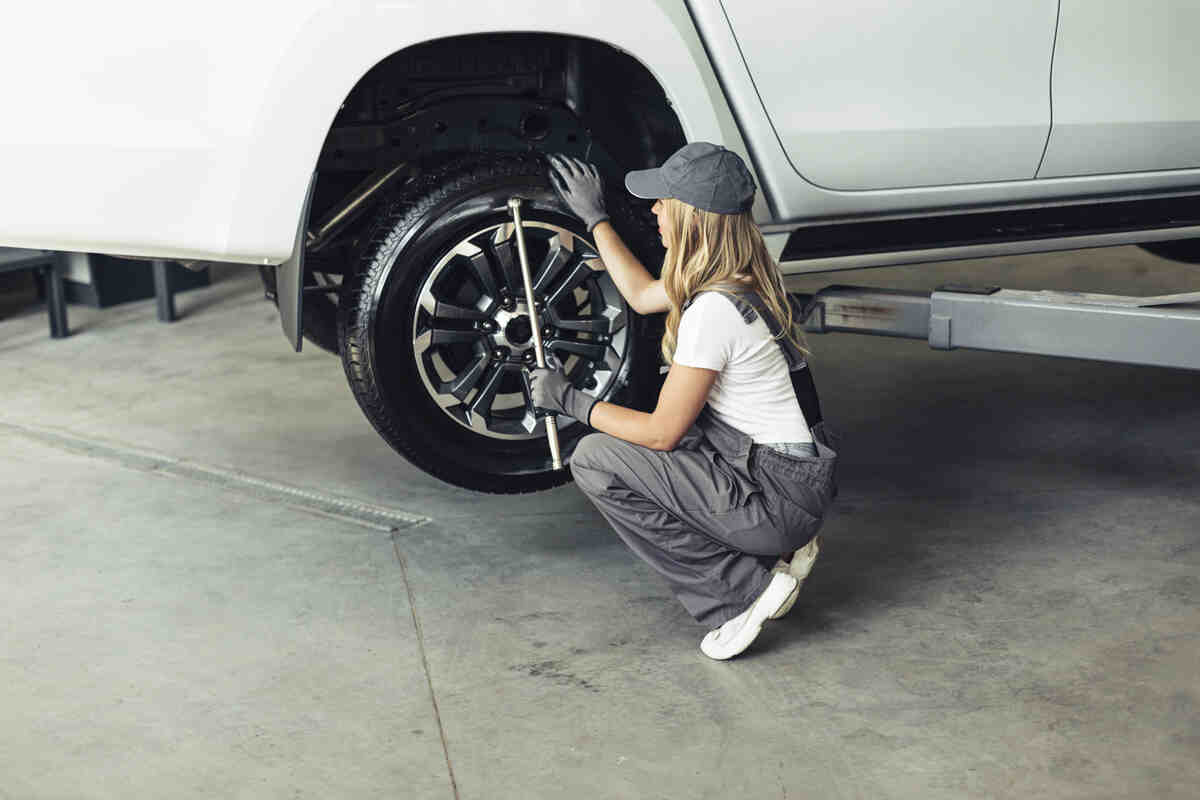Introduction
Should you ever find yourself broke down at the side of the road with a flat tyre. A spare tyre (st) is manna from heaven. But it’s fun to know just how fast you can go on a spare tire. It may surpise you to learn that this question. Is more important than you may imagine, and so knowing the answer can prevent a tragedy on the way home. Let me provide you detailed information on this topic so that you can be ready for any type of situation.
What Is a Spare Tire?
A spare tire is a tire that is normally provided in your car to supplement. The regular ones in case of a flat, damaged or a change in a tire type. The three main types of spare tires:The three main types of spare tires:
- Full-Size Spare: This is basically a standard tire and wheel, that will be of the same size as those of your car right now.
- Compact Spare: Also termed as the “donut,” it is a tiny spare tire. Lighter in weight and used for consuming less space in your car.
- Temporary Spare: Just like its counterpart compact spare. But it has no moment sign and is not intended for long-term use and is even lighter.
Why You Shouldn’t Drive Fast on a Spare Tire
They are intended for use to get you to the closest repair center and not to be used. As a normal tire. Driving fast on a spare tire can lead to various risks:Driving fast on a spare tire can lead to various risks:
- Reduced Traction: Tire spares tend to be worn out as compared to normal tires. Because they spend most of their time unused, therefore have less traction on the road.
- Imbalanced Handling: Spare tires are often smaller than the standard ones. Which cause some unbalance and, therefore, can lead to difficult control of a car at high speed.
- Increased Wear and Tear: Driving fast on a st can bring the corresponding st impermeable and thus raise the possible chance of a blowout.
Recommended Speed Limits for Spare Tires
It therefore goes without saying that when on a spare tire. One has to abide by the given upper speed limits for your safety and the durability of the tire. Temporary or compact tires mounted on spare cars are not designed to achieve high speeds as the normal tires. Almost all cars produced by different manufacturers have a maximum speed limit they advise to maintain. When using a spare tire of 50mph or 80km/h. This guideline exists because spare tires are usually a small or a towing tire with significantly less tread than. The original equipment that offers less gripping forces, as well as less stability on the road.
Moving at the velocity higher than this can lead to consequences. Such as tire blow-off, loss of control, and or being prone to accidents. As a result, one must not go fast and should drive safely until he manages to fit the spare with any ordinary tire. In every type of vehicle, there is always a specified speed to be used when operating. The spare tire and this should always be found in the manual.
How Far Can You Go on a Spare Tire?
Whereas speed is always a plus, distance is also an important element. The general guideline in this regard is that the car should not be driven over 70 miles (113 km) with the spare tire on. However, this can vary depending on the type of spare tire:However, this can vary depending on the type of spare tire:
- Full-Size Spare: It can be driven more kilometers. But better to replace it with a normal tire within shortest possible time.
- Compact and Temporary Spares: Primarily intended for short distance use, and this is to see you through to the nearest mechanic shop.
Tips for Driving Safely on a Spare Tire
- Regularly Check Tire Pressure: Tire spares are usually left idle for a long time and thus the pressure from time to time may reduce. You should check it probably as often as you want to use it to make sure it is immediately accessible.
- Avoid Highways and Long-Distance Travel: According to current experience, high speeds and great distances on a spare tire are very unsafe. Stay on local streets when you can.
- Minimize Sharp Turns and Braking: That is, rapid acceleration or deceleration puts pressure on a spare tire which may develop a blowout.
What to Do If Your Spare Tire Fails
While using the spare tire and in the event the spare tire develops problems. There are certain things that should be done immediately and safely. The first thing that may indicate that the spare tire is failing may be odd shaking, sounds, or problems dealing with your car. These are early signs of root caused issues, if you see any of these, slow down and find a rest area to stop. Never try to keep on driving because a bad area can result to a blowout. Which is very hazardous to the driver and other road users.
If you have reached the safety of a suitable location. Switch on the car’s hazard lights to warn other road users. In the case where you have a tire repair kit or if you have a second spare tire you can try to come up with a temporary solution to this problem. But usually it is wiser to request a roadside assistance service. This service is incorporated in many insurance policies, and can assist you in preventing such problems.
If you are located at an area that they cannot get a cell signal, then try to wave at a passing car for assistance. It is also useful to have a portable tire inflator, or better still. A tire sealant as this it can help to offer a quick solution to enable one get to the workshop. But these solutions are not lasting; it is recommended to get an ideal tire replacement. As soon as possible to avoid any risk on the road.
When to Replace Your Spare Tire
For this reason, obtaining a new tire to replace your worn out tire is an activity that is as useful as keeping up your normal tires. Time specified spare tyres are not exactly standard or large ones and are meant to be used only when actually needed; not for extended periods. One standard practice is to replace the st every six years or so even if the st has not been employed at all. Rubbers can wear out over time, not necessarily when the tire is being used. Thus the failure to be relied upon in the event of an accident.
It is also recommended that you should change your tire if it is worn out.This is measured by signs that are evident in your tire; they include. Cracking of the rubber, uneven surface, and distortion as a result of extreme temperature storage. Also, if the st has been run for over its recommended number of miles, usually 70, you are advised to get another one.
In the course of the regulation maintenance checks, make sure that your ste is in the right conditions and has on the right pressure. As is often the case, a good tire can save your life in an emergency. So one should not disregard it. It is always advisable to replace your spare tire before it turns. Into a risk and so as to have prepared you for any occurrences on the road.
Alternatives to Spare Tires
Over the last few years, there has been an influx of alternatives to spare tires. These include:
- Run-Flat Tires: A run-flat tire is one we can drive on for a certain amount of time following loss or reduction in air pressure.
- Tire Repair Kits: These tire repair kits can seal a leak long enough so you can drive to your nearest flat-fix store.
- Roadside Assistance: If you have flat tyre and don t carry a spare, your auto insurance can be of great help when using this feature.
- Common Myths About Spare Tires
- Myth: You can drive normally with the spare
- False. They must be driven no more than 50 mph because spare tires are not meant to drive for long periods at high speeds
- Myth: Spare Tires Last as Long as Regular Tires
- False. Spare tires come in all shapes and sizes, serving different purposes. You should definitely call the spare tire something other than ‘garage gym programming.n.
- Myth: All Donuts Tires Are the Same
- False.The same goes for spare tires, they have a lower lifespan as well and are to be used temporarily only.
- Real-Life Stories: What is the Consequence of not Adhering to Spare Tire Recommendations
- It is important therefore to note that failure to adhere to the prescribed use of spare tires leads to serious consequences. Consider the following real-life cases:Consider the following real-life cases:
- Over-speeding is an often encountered problem that penalizes the vehicle occupants in the most vulgar ways, as showcased by the following case:
- Case 2: Going beyond the prescribed mileage limit.Another driver wrote about using a spare tire for more than five hundred miles. This particular tyre eventually got blown, and the driver was left sulking in an area that no assistance was nearby.
Conclusion
It’s very essential to be more cautious and alert when driving the car with a spare tire. Knowing what your spare tire can and cannot do – its top speed. How far it can take you, how it handles – matters to keep you safe. Try it to be rotated with the normal tire as soon as possible, and never overuse the spare tire.
Read More: What Is “Tech” Short For?














Leave a Reply